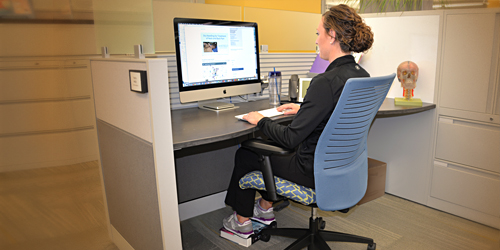
By Peter Till, PT, DPT, MTC, ATC
Ergonomics is defined as “an applied science concerned with designing and arranging things people use so that the people and things interact most efficiently and safely.” This is beneficial because you perform best at work when you are comfortable and able to focus.
Staying in the same position for a prolonged period is not healthy. There is 33% more pressure on the discs in the lower back when sitting compared to standing. So if you spend a good deal of time sitting at a desk, you should stretch and move to avoid stress to your back and neck. Be sure to frequently stretch your fingers, hands, arms and torso. Make time to periodically stand up and walk around for a few minutes.
Here are five considerations when designing the perfect work environment at your desk:
- Head. The monitor should be directly in front of you, slightly below eye level, and at least 20 inches away. Your head should be set back over your spine so that if someone looked at you from the side, your ears would line up with your shoulders.
- Eyes. Rest your eyes periodically by focusing on objects that are father away by approximately 20 feet. Stop, look away, and blink at regular intervals.
- Keyboard. Keep the keyboard in front of you. Your shoulders should be relaxed and your elbows close to your body. Your wrists should be straight and in line with your forearms.
- Chair. If possible, make small adjustments to your chair, like changing the chair height and adjusting the backrest to support the natural inward curvature of your lower back. It may also be useful to use a rolled towel to support your lower back.
- Legs. The height of your chair should allow your feet to rest flat on the floor. Use a footstool, if necessary. Your thighs should be parallel to the floor and your knees and hips should be at about the same level; each in a 90 degree position.
Use these tips to assess your current workspace and reconfigure, as needed, to set yourself up for success!
Peter Till, PT, DPT, MTC, ATC is a physical therapist with Mayfield Brain & Spine.